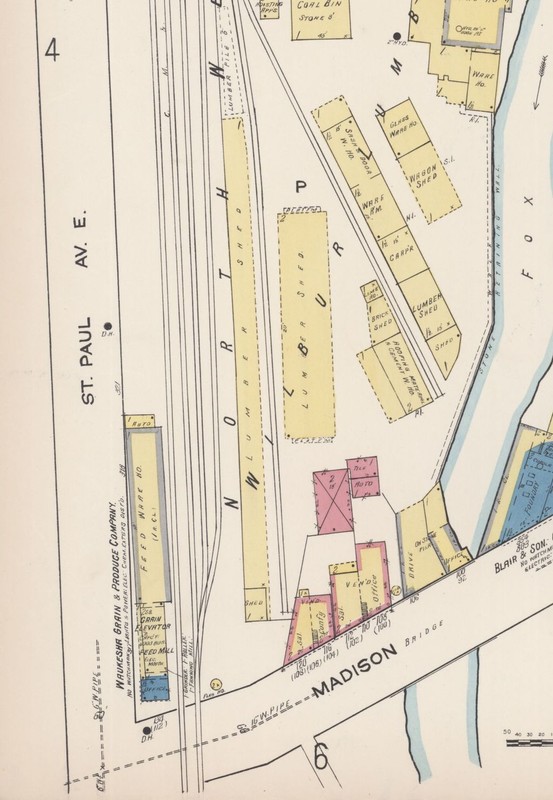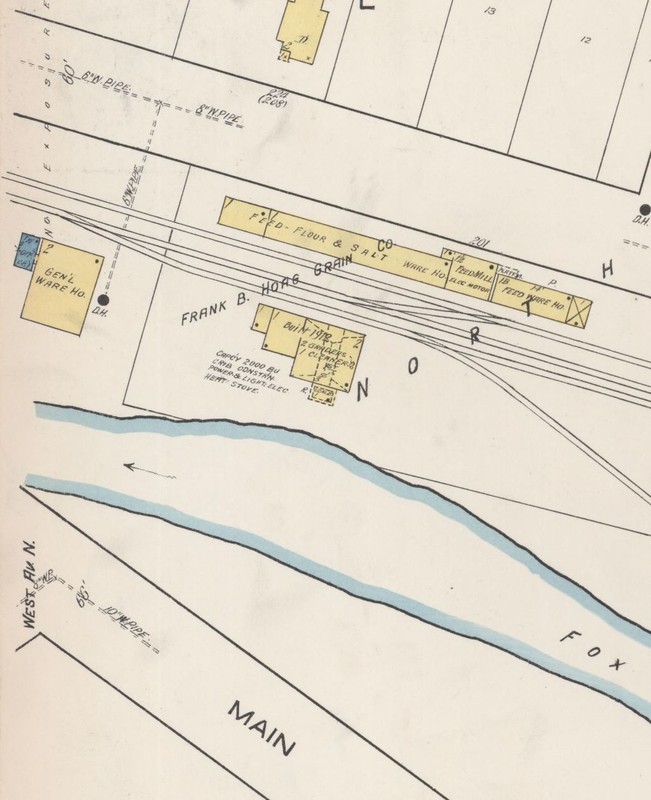Waukesha Grain and Produce Company
Introduction
Text-to-speech Audio
At one time Waukesha housed five different flour and feed mills. These included the Waukesha Grain and Produce Company, as well as the Hoag & Rankin Grain Company. Although wheat was originally the grain of choice in Southern Wisconsin, it soon changed to feed grains as the dairy industry began to boom. The Waukesha Grain Company specialized in this ground feed, and advertised mainly to local farmers.
Images
Waukesha Grain and Produce on 1922 Sanborn Map

Hoag Grain Co on 1922 Sanborn Map

Backstory and Context
Text-to-speech Audio
According to newspaper records The Waukesha Grain and Produce Company came into existence around 1893. At this time the president of the Waukesha Grain and Produce Company was Samuel Albert Fox, born in England in 1840. Fox immigrated to the United States around 1860, and married Ann Eliza Smart, related to Isaac Smart, one of the first pioneers of Waukesha.
In 1904 the company was passed to James Brimmer, who ran the company along with Frank Smart. It was while Smart and Brimmer were in charge of the company that a fire broke out. In the February of 1908, a fire consumed the grain elevator at the company. Firefighters struggled to put out the fire, as the hydrant was frozen, but were eventually able to extinguish it, saving the elevator and property at the Hoag Grain Company in the process. The summer of 1909, the Waukesha Grain and Produce Company rebuilt, raising a warehouse behind their offices and installing equipment to help with the sorting and cleaning of grains.
As the popularity of dairy farming increased, both the Waukesha Grain and Produce Company and the Hoag Grain Company advertised their feed grains to local farmers. Wisconsin wheat farmers struggled to compete with outputs in Iowa and Minnesota, and grain feed soon became a more profitable industry. This development marks the decline of wheat mills in the area, such as the Saratoga Mill, demolished in 1925. By 1900 about 90% of agricultural acreage in Wisconsin contained feed crops.
While there is little concrete information about the Waukesha Grain and Produce Company or the Hoag and Rankin Grain Company, they remain as prime examples of the industries of the time. In particular, the emphasis on producing feed grain reflects the growing importance of dairy in Wisconsin, as well as the diminishing popularity of wheat.
Sources
Ann Eliza Fox, FamilySearch. Accessed August 17th, 2022. https://www.familysearch.org/tree/person/details/L7PV-YCY.
"Bad Blaze at Waukesha." Wood County Reporter (Grand Rapids) February 6th, 1908. 3.
Cultural Resource Management in Wisconsin. Volume 2. Wisconsin. State Historical Society of Wisconsin, 1986.
Farming and Industry: How a Disaster Made Wisconsin the Dairy State, Wisconsin Historical Society. Accessed August 26th, 2022. https://www.wisconsinhistory.org/Records/Article/CS407.
Memoirs of Waukesha County. Madison, Wisconsin. Western Historical Association, 1907.
"Notice." The Waukesha Freeman (Waukesha) December 8th, 1904. 8.
"Raising the Warehouse." The Waukesha Freeman (Waukesha) August 5th, 1909. 1.
Samuel Albert Fox, FamilySearch. Accessed August 17th, 2022. https://www.familysearch.org/tree/person/details/L4JZ-S1J.
Library of Congress
Library of Congress
